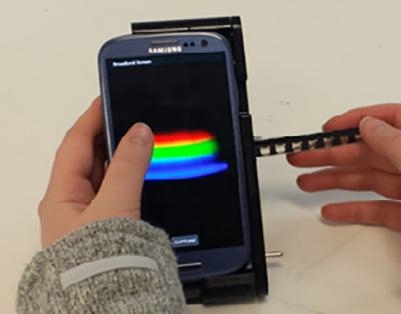11 August 2017. An engineering lab at University of Illinois created a device that uses a smartphone’s imaging and processing features to analyze human specimen samples for detecting disease. Bioengineering professor Brian Cunningham and colleagues in Urbana-Champaign describe their device in the 24 July issue of the journal Lab on a Chip (paid subscription required).
Cunningham’s team is seeking reliable techniques and systems that analyze a patient’s condition at the point of care, rather than sending specimens from the patient off for testing in a separate or remote lab. Their hand-held system, called the Tri-Analyzer — short for transmission-reflectance-intensity — combines features of microfluidic or lab-on-a-chip devices to capture and flow blood, saliva, and urine samples, with a smartphone’s camera, lights, and processing features.
The Tri-Analyzer acts as a high-resolution spectrometer, a common piece of lab equipment that measures changes in light waves through a sample to determine its composition. Blood, saliva, or urine samples are captured on a cartridge with a number of separate compartments inserted into the device, where the smartphone’s built-in LED camera flash or a diode in the device illuminates the sample. Light from these sources is sent through the sample cartridge or read by a light-sensitive crystal biosensor.
Light waves transmitted through the samples or from the biosensor are collected and sent by an optical fiber through a grate that diffracts or spreads the light into a spectrum, for reading by the smartphone’s rear-facing camera. The camera then captures the spectra images as video for analysis by software installed on the phone.
The Illinois team demonstrated the Tri-Analyzer with two tests associated with maternal and infant health. One test processes samples for fetal fibronectin proteins that bind the baby to the uterus, and after 35 weeks begin to break down, where it becomes detectable. If fetal fibronectin breaks down too early, it’s an indicator of possible pre-term birth. The second test measures samples for phenylalanine, a component of proteins. In rare cases, babies are born without the ability to adequately process phenylalanine, a condition known as phenylketonuria, where phenylalanine builds up, leading to intellectual disability and other serious health problems.
The researchers report the Tri-Analyzer successfully evaluated samples for both conditions, with detection ability comparable to commercial enzyme-linked immunosorbent assay, or Elisa, tests on conventional medical lab equipment.
In a university statement Cunningham calls the TriAnalyzer, “the Swiss Army knife of biosensing.” Cunningham adds that, “It’s capable of performing the three most common types of tests in medical diagnostics, so in practice, thousands of already-developed tests could be adapted to it.”
Cunningham estimates the cost of the Tri-Analyzer at $550.00. The university says the technology already has a patent, but is available for licensing.
More from Science & Enterprise:
- Chip-Phone System Detects Disease Biomarkers
- Lab-On-Chip Quickly Isolates, Captures Exosomes
- Chip Device Quickly Detects Sepsis in Blood
- Simple, Inexpensive Pathogen Detector Developed
- Fund Created for Point-of-Care Diagnostics, Treatment
* * *


 RSS - Posts
RSS - Posts
[…] Smartphone Attachment Performs Medical Diagnostics […]